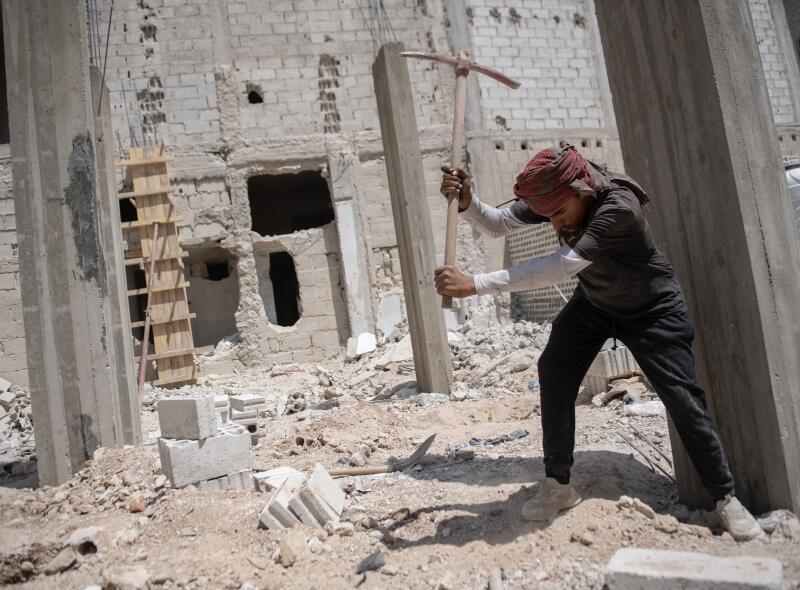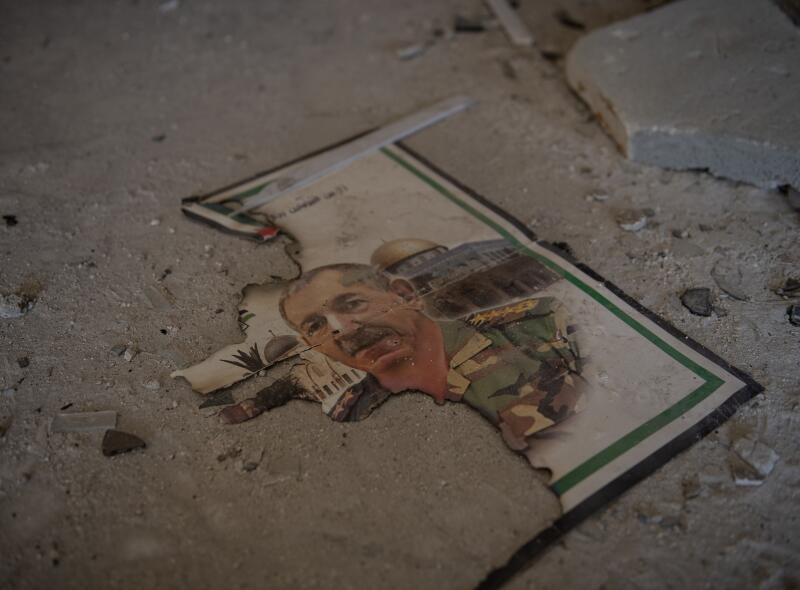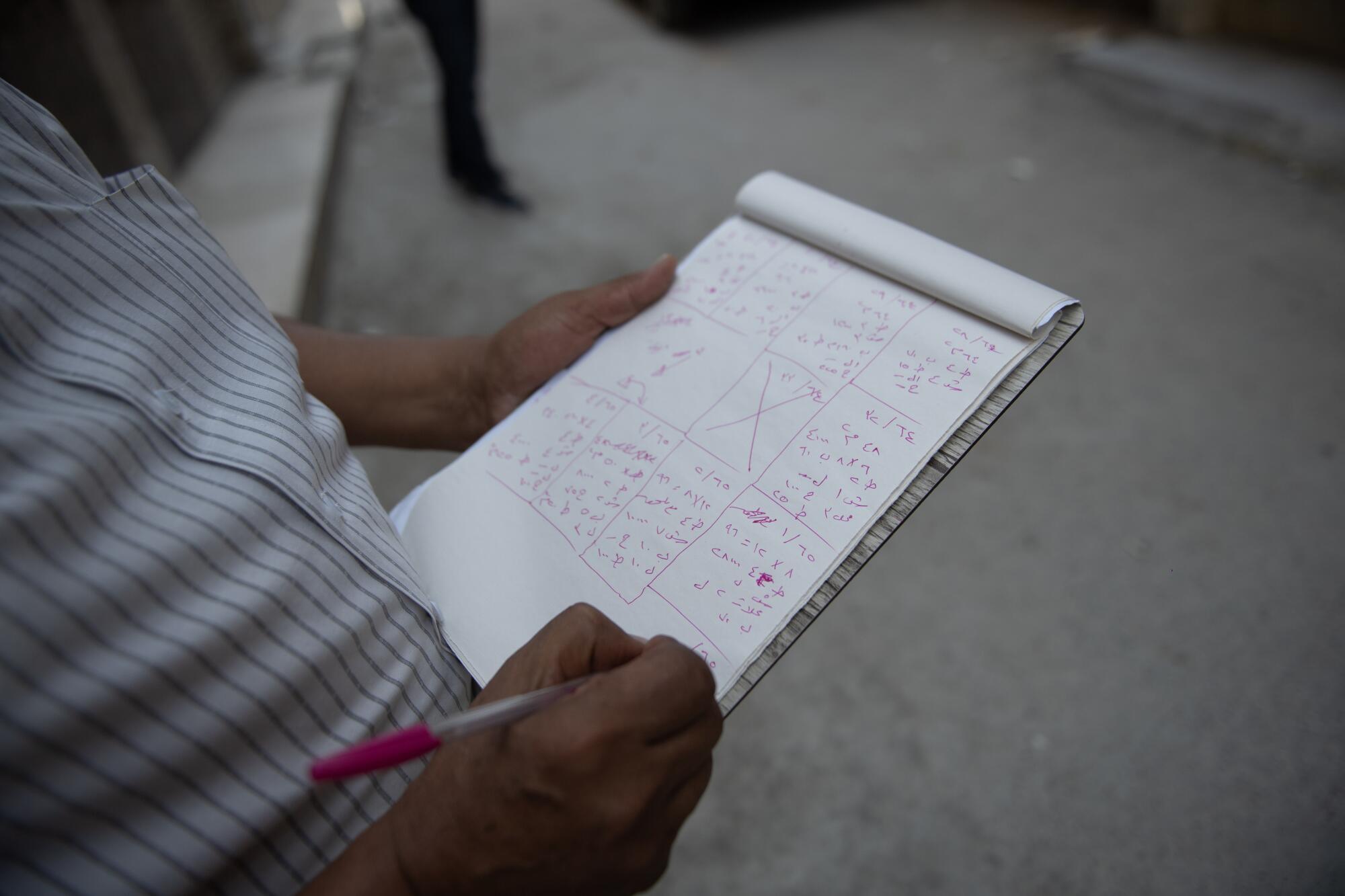YARMOUK, Syria — On a ferociously scorching summer season morning, the inspectors stepped gingerly by an alley and solid a essential eye on the war-withered buildings on this sprawling Palestinian refugee camp on the sting of Damascus.
The alley was typical of what Yarmouk had develop into after 14 years of Syria’s grinding civil battle, which had reduce the camp’s inhabitants from 1.2 million individuals — 160,000 of them Palestinian refugees — to fewer than a number of hundred and turned what had been the de facto capital of the Palestinian diaspora and resistance actions right into a wasteland.
The ramshackle buildings that survive — typically with lacking roofs and partitions, and stairs main nowhere — have little in frequent, save for his or her shambolic, advert hoc building designed much less for permanence than velocity and low value. Most have a sprinkling of holes picked out by bullets or shrapnel.
“Nothing to repair here. This one we have to remove completely,” mentioned one of many inspectors, Mohammad Ali, his eyes on a pile of indeterminate grey rubble with an orphaned staircase popping out of its facet.
He pressed a pill to document his evaluation and sighed as his companion, Jaber Al-Khatib, hoisted himself up on a wall and examined the skeletal stays of a bombed-out, three-story constructing.

1. A mom and her youngster stroll down one of many destroyed streets in Yarmouk, the as soon as vibrant Palestinian camp outdoors Damascus. 2. A pile of rubble displays the injury to the Yarmouk headquarters of the Standard Entrance for the Liberation of Palestine – Basic Command.
“The columns seem OK,” Al-Khatib known as out.
Ali raised the iPad and snapped an image he would later add to a central database. It was a bit after 9 a.m. and the warmth was already creeping previous 96 levels. And so they nonetheless had loads of buildings to evaluate.
“All right. Let’s move on,” he mentioned.
Mapping the injury in Yarmouk would require a number of weeks extra for the volunteer engineers within the Yarmouk Committee for Neighborhood Improvement. However the work is seen as very important in reviving a as soon as thriving group.
Successive waves of preventing and airstrikes, to not point out the looting that inevitably adopted, had left round 40% of the camp’s 520 acres broken or destroyed. Very important companies like electrical energy, water and particularly sewage are at finest intermittent or unavailable. Even now, mountains of rubble — sufficient to fill 40 Olympic-sized swimming swimming pools, the committee estimates — line nearly each road.

Jamal Al-Khatib, an engineer, takes images as he conducts a survey of broken buildings in Yarmouk, Syria.
(Hasan Belal/For The Instances)
“Compared to its size and population, Yarmouk paid the highest price across Syria in terms of damage and hardship,” mentioned Omar Ayoub, 54, who heads the committee and was coordinating with Al-Khatib, Ali and different engineers on the evaluation. Although giant swaths of Yarmouk are nonetheless in ruins, circumstances are actually “five stars” in contrast with 9 months in the past when then-President Bashar Assad fled the nation, Ayoub mentioned.
Nonetheless, individuals have been gradual to return. Solely 28,000 individuals have come again, 8,000 of them Palestinians, in line with Ayoub and support businesses. For them and the tens of hundreds nonetheless hoping to come back again to Yarmouk, the idea of “home” — whether or not right here or in locations their households left behind after the 1948 battle and Israel’s founding — has by no means appeared so far-off.
“It used to feel like a mini-Palestine here. Streets, alleyways, shops and cafes — everything was named after places back home,” Ayoub mentioned.
“Will it come back? Life has changed, and the war changed people’s convictions on the issue of Palestine.”
That picture of how life in Yarmouk as soon as was drew Muhyee Al-Deen Ghannam, a 48-year-old electrician who left the camp in 2013 for Sweden, to go to final month. He was exploring the thought of bringing his household again, however the landmarks he as soon as used to find his condo had been all gone. He finally discovered it, nonetheless standing, however stripped of something of worth.
“Living here, you had such a strong connection to Palestine, and yet we never felt like foreigners in Syria,” Ghannam mentioned.



1. Years of warfare have devastated most streets in Yarmouk, Syria. 2. A building employee labors in Yarmouk. Few of the previous residents have returned to the camp. 3. A lady and her mom go to the grave of a relative within the Yarmouk cemetery amid the devastation prompted through the Syrian civil battle.
He gained’t be leaving Sweden. “I was planning on staying [here]. But with kids, it would be very difficult.” His 16-year-old, he added, hoped to review aeronautics — an impossibility in Syria.
Many others had been compelled again to Yarmouk by sheer economics, together with Wael Oweymar, a 50-year-old inside contractor who returned in 2021 as a result of he might now not afford hire in different Damascene suburbs. He spent the final 4 years fixing up not solely what remained of his condo, however its environment.
“What could I do? Just give up and have a heart attack?” he mentioned, cracking a simple smile.
“You see this street?” he mentioned. “I swept this whole area myself. There was no one here but me — me and the street dogs. But when people saw things improving, it encouraged them to return.”
Oweymar counted {that a} victory.
“It was systematic, all this destruction. The intention was to make sure Palestinians don’t return,” he mentioned, echoing a typical suspicion amongst Yarmouk’s residents, who imagine the Assad-era authorities deliberate to make use of the preventing to displace Palestinians and redevelop the world for its personal use.
“But they destroyed and we rebuild,” Oweymar mentioned. “We Palestinians, we’re a people who rebuild.”
Oweymar’s phrases had been a measure of the uneasy relationship the Assad household maintained with Palestinians. In contrast with Palestinian refugees in Jordan and Lebanon, these in Syria — now estimated to quantity 450,000 — had been handled properly. Although by no means granted citizenship, they might work in any career and personal property. Beneath the rule of Assad’s father, Hafez, Palestinians enlisted in a particular corps within the army known as “The Liberation Army.”



1. In Yarmouk, it’s frequent to see buildings lacking partitions or roofs. Many are pockmarked by bullets or scrapnel. 2. Yarmouk as soon as had 1.2 million residents. Estimates say about 28,000 individuals dwell there now, 8,000 of them Palestinians. 3. Amid some rubble lies the burnt and torn picture of Ahmed Jibril, the onetime secretary basic of the Standard Entrance for the Liberation of Palestine – Basic Command.
Factions, such because the Standard Entrance for the Liberation of Palestine and Hamas, opened coaching bases within the nation and administered camps. On the identical time, Syrian safety companies pursued Palestinians with the identical diligence they confirmed towards homegrown dissidents.
Assad continued his father’s insurance policies and aligned Syria with the so-called Axis of Resistance, an Iran-backed community of factions arrayed in opposition to the U.S. and Israel that championed the Palestinian trigger. But greater than 3,000 Palestinians had been imprisoned through the civil battle — only some dozen emerged alive.
“Assad became the standard bearer for Palestinian resistance, putting it above anything he did for Syrians. But he also slaughtered Palestinians in huge numbers. We never knew where we stood with him because of that duality,” Ayoub mentioned.
When the civil battle started, a miniature model performed out in Yarmouk. Some factions insisted on neutrality, whereas others sided with Assad or the rebels in opposition to him. The Syrian army laid siege whereas the factions duked it out inside Yarmouk.
Neighborhoods grew to become run-and-gun entrance traces; fighters punched holes by buildings’ partitions to keep away from ubiquitous sniper hearth. In 2015, jihadists from the Islamic State seized the camp. Because the battle stretched on, so did the siege, with rights teams estimating not less than 128 individuals died of hunger. Ayoub, now a portly scriptwriter with an avuncular smile, weighed a mere 66 kilos through the siege.
“We had more people die here because of hunger than Gaza,” Ayoub mentioned, referring to the enclave the place Israel has mounted a blockade that support teams warn has resulted in famine.
“Our ultimate dream was to eat our favorite food before we died. One neighbor, I remember, he was craving a French fry — just one,” Ayoub mentioned, a wan smile on his face on the reminiscence.

Mohammad Ali, 63, is among the engineers working to survey the broken buildings and assess their wants for future reconstruction in Yarmouk.
Islamic State was lastly pushed out in 2018, however Assad’s forces, together with common army items and allied factions, pillaged no matter hadn’t been destroyed, even setting fires inside properties to pop tiles off of partitions. They ripped out bathrooms, window frames and light-weight switches and offered the copper wiring.
Eight months since Assad’s ouster, there may be little readability on what stance Syria’s new authorities will take concerning the Israeli-Palestinian battle.
Many officers say Syria is in no situation to interact in a battle with Israel, and that it has already paid sufficient for its advocacy for Palestinians. The U.S., in the meantime, has brokered high-level contacts between Israeli and Syrian officers, and conditioned help on the brand new authorities suppressing what the U.S. classifies as “terrorist organizations,” together with a variety of Palestinian factions.
There are already indicators Damascus has moved to satisfy these calls for.
Abu Bilal, a member of the Standard Entrance for the Liberation of Palestine who gave his nom de guerre as a result of he was not allowed to talk to the media, nonetheless minds the occasion headquarters in Yarmouk. Although the group remained resolutely impartial through the civil battle, after Assad fled, gunmen affiliated with the brand new authorities confiscated the group’s weaponry and coaching camps.
“Their message was clear: No political activity or military displays. We can only engage in social work or academic research,” he mentioned.

A constructing broken through the 14-year Syrian civil battle types a backdrop for a cemetery in Yarmouk, as soon as a thriving Palestinian camp.
None of that elicits sympathy from Al-Khatib and Ali, each of whom served of their youthful days within the Liberation Military.
“All the [Palestinian] factions should have stayed neutral and blocked any side, Assad or the rebels, from entering. Had they stayed united, they would have protected the camp,” Al-Khatib mentioned.
He waved on the panorama of destruction earlier than him.
“Now Palestinians are more impoverished than ever. All the factions did was destroy the economic infrastructure in Yarmouk,” he mentioned.
He paused earlier than the fire-scorched carcass of what appeared to have as soon as been a furnishings store.
“See the burns here?” Ali mentioned. “You can tell they’re from looting, not war damage. But since we don’t know how long it burned, we don’t know if the concrete is affected.”
Al-Khatib seemed on the scorch marks on the ceiling then shook his head on the ruins earlier than him.
In current weeks, extra nations have mentioned they might acknowledge a Palestinian state, however right here there are extra rapid worries.
“What time do we have now to think about or fight for a state?” Al-Khatib requested. “Our only concern is securing our homes.”

